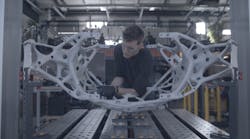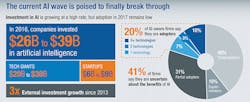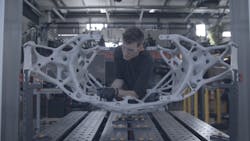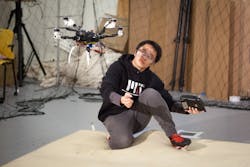In part 1 we reviewed why artificial intelligence (AI) is moving slowly. In short, AI is growing and will continue. Reports which say growth is slow may be looking into specific trends, industries, or AI on a mass scale. However, maturity, confidence, ROI, scaling, and connectivity might be slowing mass adoption. Additionally, we saw what AI can do in manufacturing. AI is amplifying design engineer’s abilities with CAD tools. As the technology grows digital twins and predictive maintenance will continue to become more accurate and add value to manufacturing.
Finally, as we look to the future of AI, it will change the way we think of factories and even education. For more information check out part 1 of the series here. In this installment we review where AI is being used and common trends in successful case studies.
Despite the overwhelming investment (as much as $40 billion in 2016), McKinsey Global Institute says 41% of firms are uncertain about the benefits of AI. (Credit: McKinsey Global Institute)
First, it is important to understand why design engineers want to use AI. There are always variables in design. What tooling, processes, and materials are going to be used to manufacture the product effectively? Today manufacturers are trying to close the gap between custom and mass-produced products. As customers demand more customization, less time between new generations of products, and more, design engineers think AI might hold the key to bridging the gap between low or custom, and high or mass-production. Today, AI is already helping streamline production and automation, along with reducing cost, adding features, and finding new revenue streams.
In the future, customers might be able to select and customize a product; from the design changes, testing, manufacturing, and shipping will have no or minimal disruption in production. The customer of the future could receive a one-off product sent to them in the similar time and cost as something mass-produced. Bridging custom and mass-production is the power of AI. Today, experts are saying manufacturers that don’t have AI technologies will not be able to compete over time. It is important to see how companies are using this technology and how it could be used to benefit your manufacturing.
Where is AI Being Used?
Earlier this year Capgemini Research Institute published a report called “Accelerating Automotive’s AI Transformation”. The report provide many examples of AI working in the automotive industry:
Dreamcatcher. AI in design can help prototyping. General Motors has applied machine learning to design products more economically and at greater speed through its Dreamcatcher system. The solution was recently tested by generating designs for a seatbelt bracket part. This resulted in 150 designs, including one that involved a single piece rather than the eight-piece original part. This one-piece design was also 40% lighter and 20% stronger. This is not only a good example of AI in design, but also that an engineer is still needed to decide which design is best for the companies needs and manufacturing capabilities.
Continental. The automotive parts supplier has developed an AI-based virtual simulation program. The program can generate 5,000 miles of vehicle test data per hour, when it currently takes over 20 days from physical efforts. With autonomous driving and Advanced Driver-Assistance System (ADAS) growing in the automotive industry, advancing and accelerating testing will increase adoption and confidence in these new technologies.
This interplanetary lander was carefully assembled by project team members at Autodesk’s technology center in San Francisco. NASA used an AI CAD tool to make this part.
Audi. Quality has always been important to companies. As industries move faster it seem a question of whether faster production will mitigate the cost of waste, or if slowing production to reduce waste is better for production and revenue. Today industries are working on both with in-line and automated inspections.
Audi is testing an AI-based system that employs smart cameras with image recognition software to test and identify tiny cracks in sheet metal. The system can potentially detect the finest of cracks using millions of images, automating visual quality inspection. The sample images are marked down to the pixel level to achieve the highest level of accuracy in detecting defects. Automated inspection can be done quickly and in-line so production doesn’t have to slow down, and waste can still be reduced or caught earlier before more is invested into a defective part.
General Motors. Predictive maintenance was another big reason why companies were interested in AI technology. Ultimaker found the cost of automotive manufacturing in the United States is $460,706 per minute, while revenue is $4,280,821—a difference of $22,480 per minute. This provides an idea of what downtime costs.
With that expense in mind, General Motors deployed a cloud-based imaging classification tool on nearly 7,000 robots. This pilot experiment was intended to detect component failures before they happened. It was able to detect 72 instances of component failure that could have led to unplanned downtime.
AI can be used to build more accurate models that have shown to improve predictive maintenance. As plants become more automated, AI predictive maintenance that can update models in real-time based on theoretical and real-world data will continue to reduce unplanned downtime to stabilize production time and reduce cost.
How to Succeed in AI Design
While unsupervised AI is still in research and development, supervised AI is already working in industry. There is a lot of confusion to the different buzzwords and hype around AI, so it is important to first understand the problem. As StrongArm Technologies CEO Sean Petterson puts it, “Fall in love with the problem not the solution.” It can be easy to focus on solutions or become distracted with new equipment and miss details or the root causes of the problem.
The first step isn’t to ask what is available and what can it do, but to understand the problem. Know who the problem affects from a macro and micro level. This will help map who will be affected as processes change and how. Also know who is having problems and who wants solutions. If a company’s or employee’s mentality is that they don’t want to change, the technology might fail no matter how great it works. Technology is only as good as the people using it. If people are in your plan you must find technology that works with them.
Like some AI generative design CAD software, MIT CSAIL developed a platform that takes input, such as payload, cost, and battery usage, and produces a custom designed drone. In this image, Ph.D. student Tao Du helps one of the team’s multi-copters take off. (Credit: Jason Dorfman/MIT CSAIL)
With a big-picture approach and understanding that support must come from the top down, but often change must be pushed from the bottom up, multiple disciplines from a range of experienced senior staff are necessary for new projects to succeed. Since AI needs a lot of data to work effectively, you will need a lot of brain power and experience to know common and special cases, anomalies, and where different tools could provide the greatest benefit with a focus on root cause analysis. In short, human intelligence is needed to guide what artificial intelligence should be doing and not doing.
According to an article from McKinsey, if an AI solution is to be developed in-house,, it will need AI creation experts that have technical, change-management, and business skills in addition to multiskilled project managerwho can act as translators. It is necessary to integrate process engineering, data science, business strategies, and management expertise into an AI solution.
Building relationships with domain experts within the company will expand workers’ understanding of what is happening and might prepare people for any changes. Working with a people outside of an employee’s day-to-day contact or normal disciplines will help offer insight to see where operations could improve, what valuable features could be added, or what additional revenue streams exist.
Building relationships will also show where it might be possible to start on smaller projects, isolated testbeds, or specific objectives to determine the technologies value and ROI. While AI benefits are often directly related to scale, starting small lets engineers fail faster and make quicker iterations to keep from mass-producing failure.
Festo, a company well known for its automation equipment, has championed interesting side projects that inevitably lead to successful new design in its Bionics program. These projects are formed with small multidisciplined groups. And Festo has given these groups:
- Freedom. Often normal approval processes won’t apply to special projects. Groups, within reason, are able to tinker and make decisions on their own. If you hire talented professionals, let them work.
- Space. In many successful projects the group is given its own space. From Festo, Apple, and even the Innovation Campus at Wichita State University, having an isolated space to work on separate projects has promoted success.
- Access to tools. Teams need to have quick and easy access to tools to keep projects moving. If a person or team needs to stop to find the software or equipment needed to tinker and experiment, it can hinder the work flow. Additionally, when working on new innovative projects, workflow interruptions can also impede thought processes.
- Inspirational role models. Festo looks for inspirational role models to keep teams excited and motivated.
While Festo Bionics is not the same as AI in manufacturing, many of the success factors are the same.
Where AI differs, according to McKinsey is, “Building a strong in-house team of IT and data specialists is a priority, as their education focuses on the key elements of AI: computer science, databases, data architecture, modeling, statistics, analytics, and mathematics. Within this group, you might consider data engineers, who are able to manage and navigate data-storage solutions and protocols, and data scientists, who can interpret and process data and create algorithms and models to solve complex, multivariable problems.”
As AI in manufacturing progresses, finding good, experienced data scientists might be difficult. This will be where third-party vendors are already working on easy-to-use, customizable tools. To find which of these tools are right for different applications it’s important to go back to understanding the problem.
Once the problem is understood, you’ll shift your focus from what’s out there and what it does to the key points of my problem, the specs that a solution must operate within, and the clear objectives and results trying to be obtained. This will save you a lot of time and hype when looking for an AI solution.




